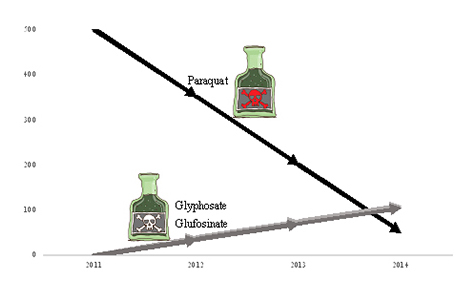1. Wu KC, Chen YY, Yip PS. Suicide methods in Asia: implications in suicide prevention. Int J Environ Res Public Health. 2012; 9:1135–1158.
2. Hvistendahl M. In rural Asia, locking up poisons to prevent suicides. Science. 2013; 341:738–739.
3. van Spijker BA, Graafsma T, Dullaart HI, Kerkhof AJ. Impulsive but fatal self-poisoning with pesticides among South Asians in Nickerie, Suriname. Crisis. 2009; 30:102–105.
4. Centers for Disease Control and Prevention (CDC). Suicide and attempted suicide: China, 1990-2002. MMWR Morb Mortal Wkly Rep. 2004; 53:481–484.
5. Hong SY, Lee JS, Sun IO, Lee KY, Gil HW. Prediction of patient survival in cases of acute paraquat poisoning. PLoS One. 2014; 9:e111674.
6. Gil HW, Hong JR, Jang SH, Hong SY. Diagnostic and therapeutic approach for acute paraquat intoxication. J Korean Med Sci. 2014; 29:1441–1449.
7. Slater R, Ellis S, Genay JP, Heimbach U, Huart G, Sarazin M, Longhurst C, Müller A, Nauen R, Rison JL, et al. Pyrethroid resistance monitoring in European populations of pollen beetle (Meligethes spp.): a coordinated approach through the Insecticide Resistance Action Committee (IRAC). Pest Manag Sci. 2011; 67:633–638.
8. Yin Y, Guo X, Zhang SL, Sun CY. Analysis of paraquat intoxication epidemic (2002-2011) within China. Biomed Environ Sci. 2013; 26:509–512.
9. Tan JT, Letchuman Ramanathan G, Choy MP, Leela R, Lim BK. Paraquat poisoning: experience in hospital taiping (year 2008 - october 2011). Med J Malaysia. 2013; 68:384–388.
10. Lee HL, Lin HJ, Yeh SY, Chi CH, Guo HR. Etiology and outcome of patients presenting for poisoning to the emergency department in Taiwan: a prospective study. Hum Exp Toxicol. 2008; 27:373–379.
11. Cherukuri H, Pramoda K, Rohini D, Thunga G, Vijaynarayana K, Sreedharan N, Varma M, Pandit V. Demographics, clinical characteristics and management of herbicide poisoning in tertiary care hospital. Toxicol Int. 2014; 21:209–213.
12. Nagami H, Maejima F, Nishigaki Y, Natsukawa S. Trends in paraquat poisoning in Japan - viewed from surveys on clinical cases. J Rural Med. 2013; 8:228–232.
13. Seok SJ, Gil HW, Jeong DS, Yang JO, Lee EY, Hong SY. Paraquat intoxication in subjects who attempt suicide: why they chose paraquat. Korean J Intern Med. 2009; 24:247–251.
14. Seok SJ, Park JS, Hong JR, Gil HW, Yang JO, Lee EY, Song HY, Hong SY. Surfactant volume is an essential element in human toxicity in acute glyphosate herbicide intoxication. Clin Toxicol (Phila). 2011; 49:892–899.
15. Song HY, Kim YH, Seok SJ, Gil HW, Hong SY. In vitro cytotoxic effect of glyphosate mixture containing surfactants. J Korean Med Sci. 2012; 27:711–715.







 PDF
PDF ePub
ePub Citation
Citation Print
Print





 XML Download
XML Download